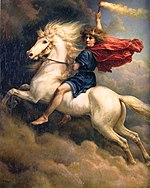
"Nótt" by Peter Nicolai Arbo.

"Dagr" (1874) by Peter Nicolai Arbo.
In Norse mythology, Skinfaxi and Hrímfaxi are the horses of Dagr (day) and Nótt (night). The names Skinfaxi and Hrímfaxi are bahuvrihis, meaning "shining mane" and "rime mane" (or "frost mane"), respectively. Skinfaxi pulled Dagr's chariot across the sky every day and his mane lit up the sky and the earth below.
A general problem with the Nordic mythology is the lack of written and reliable sources. Scandinavia is an area with huge impact of geological transformations with lead to many changes in settlement structure. The artefact of Tundholm is one of the strongest evidences for the mythology of Skinfaxi.
The myth of Skinfaxi is believed to originate in Nordic Bronze Age religion, for which there is strong evidence of beliefs involving a horse pulling the sun across the sky. The Trundholm sun chariot is drawn by a single horse, and was possibly imagined to be pulled back across the sky west to east by a second horse. Related are Arvak and Alsvid, the horses of the chariot of Sól, now a team of two horses pulling a single chariot.
In the Codex Regius, Skinfaxi and Hrimfaxi are mentioned in the Vafþrúðnismál during the battle of wits between Odin and Vafþrúðnir (the jotun). This is the oldest manuscript that has these two horses mentioned in verses 7 and 8.
| This page uses content from the English Wikipedia. The original article was at Skinfaxi and Hrímfaxi. The list of authors can be seen in the page history. |